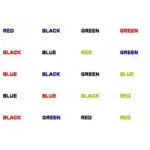
Sometimes people have such automated responses in our brain that conflicts appear when solving certain tasks that “contradict” said automation. In this article we will learn about one of these interferences, the simon effect.
The Simon effect was proposed by JR Simon in the late ’60s, and consists of responding faster and more accurately when the stimulus we must detect appears in the same relative space as the response to be emitted.
The Simon effect: what does it consist of?
In a study of basic psychology, which consisted of an auditory task where subjects had to identify the frequency at which a certain sound was emitted, pressing the button located on the right for low frequencies, and the left for high frequencies. The sounds were presented randomly in one ear or the other.
Although initially, when proposing the paradigm, the initial hypothesis was that the origin of the sound was irrelevant to the task, the results of the study contradicted this hypothesis, since the subjects tended to respond stereotypically in the same sense as the of origin of the stimulus: this phenomenon, discovered by Simon and Berbaum (1990), is known as the Simon effect.
The Simon Effect It is considered an interference phenomenon, which is located in the stage of selection of the response by the subject (when the subject must respond). That is, this means that such an effect affects the response stage in information processing.
Thus, the Simon effect refers to the fact that a subject’s reaction times when responding are usually faster, and the reactions or responses are more accurate (more accurate), when the stimulus to be detected appears in the same relative location as the response (as we have seen above). This happens even if the location of the stimulus is irrelevant to the task at hand.
The name of the effect is because JR Simon was the first to publish this phenomenon, in the late ’60s. JR Simon’s original explanation was that there is an “innate tendency to respond towards the source of the stimulus”, with the source being understood as the place of origin or origin of the stimulus.
In other words, the Simon effect appears in a certain task when interference occurs ; In this case, the position of the stimulus and the assigned response do not correspond. The effect would be the result of a conflict between the irrelevant information coming from its spatial position (for example, it appears on the right) and the relevant information conveyed by the stimulus.
Information processing models
Simple information processing models establish three stages for information processing:
In this sense, as we have already seen, it is thought that the simon effect would imply interference in the second stage, the response selection stage.
JR Simon Explanation
JR Simon (1969) maintains that the position of the stimulus (even if it is irrelevant to the task), directly influences response selection. This is because there is an automatic tendency to react towards the source of the stimulus, so that performance is worse if the stimulus that appears there requires an opposite response.
The explanations to understand the Simon effect mostly refer to the interference mentioned in the response selection stage when making a decision; neurologically, It is believed that the anterior cingulate cortex would be involved in such processing and it is thought that it could be responsible for causing the Simon effect.
Thus, it can be argued that the information about the position or source of the stimulus could not be ignored, and would significantly affect our decision or response, even if the responding subject knows that the information is irrelevant.
Other explanations
Another explanation of the Simon effect is that it is due to the automatic generation of conflicting spatial codes. In this way, the fact that the Simon effect is of greater magnitude when responses are issued relatively quickly suggests that may depend on an automatically generated spatial code which remains active for a short period.
On the other hand, and in turn, the inverse Simon effect demonstrates that it is possible for the effect to appear with responses issued more slowly, which demonstrates the possible participation of intentional processes of logical recoding under the control of the subject.
The Stroop Effect
The Simon effect produces uinterference similar to that which occurs in the Stroop effect. The Stroop effect (or Jaensch effect) consists of semantic interference produced as a consequence of our automaticity when we read; This occurs when the meaning of the word interferes with the naming task, for example, the color in which it is written.
Thus, if for example we see the word “red” written in black, and we must say the color and not the word, it will take us longer to respond and we will make mistakes more easily than if the word is “black”, it is written in black, and We must also say the color (because it matches).








